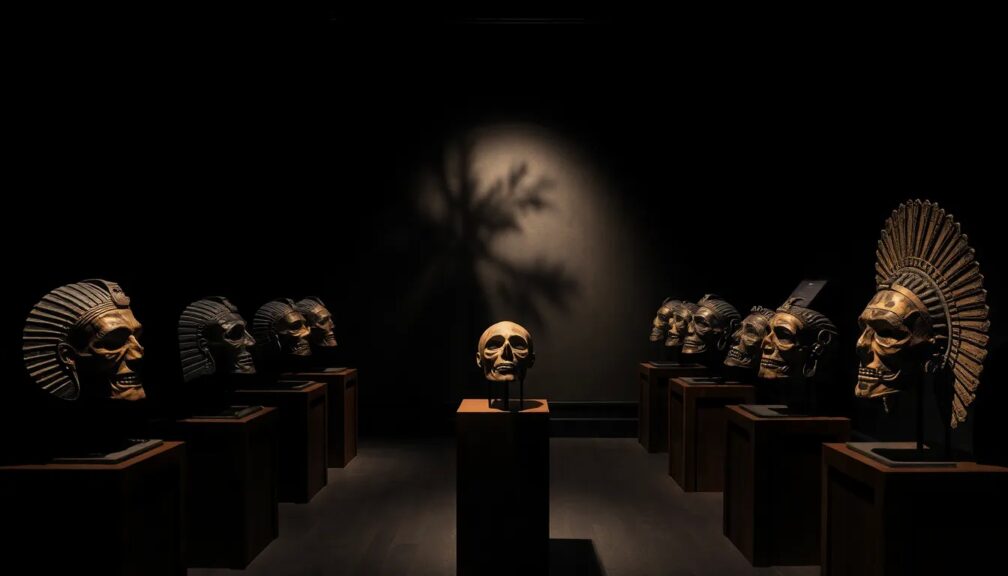The Fascinating World of Death Masks

Did you know that the ancient Egyptians famously crafted death masks to honor their deceased pharaohs, believing that these masks would help the souls transition to the afterlife? These intricate artifacts not only served as a final farewell but also reflected a rich tapestry of cultural beliefs surrounding death and the afterlife. The most famous among them is perhaps the death mask of Tutankhamun, adorned with precious materials and craftsmanship that speaks to the reverence of the time. This captivating practice of creating death masks has persisted throughout history, capturing the likenesses of the deceased and providing a unique window into the customs surrounding death across various cultures.
Exploring the realm of death masks reveals a multi-faceted narrative that spans centuries and continents. From the Roman wax death masks that celebrated notable figures to the haunting beauty of Marie Antoinette's death mask, each artifact tells a story of its own. This article will delve into the history, cultural significance, and artistic techniques behind death masks, exploring their evolution and the roles they play in different societies. We will also touch on the most notable examples, including the famous death masks of historical figures, and examine how they have shaped our understanding of life, death, and legacy.
The Historical Context of Death Masks
The tradition of creating death masks dates back thousands of years, with some of the oldest known examples originating in ancient Egypt. The Egyptians believed that preserving the likeness of the deceased was essential for their journey into the afterlife. These masks were often made of gold, silver, or plaster and were placed over the faces of mummified bodies. The most iconic example is the death mask of Tutankhamun, a testament to the artistry and spiritual beliefs of ancient Egyptian civilization. Crafted in the 14th century BCE, this mask was designed to ensure that the young pharaoh’s spirit could recognize his body and find peace in the afterlife.
As we move through history, we see the evolution of death masks across various cultures. In ancient Rome, notable individuals such as politicians and military leaders were honored posthumously with wax death masks that captured their likenesses. This practice became a way for families to honor their lineage and maintain a connection to their ancestors. These masks were often displayed in homes or public spaces, serving as a form of ancestral worship and a reminder of the virtues associated with the deceased.
The practice of creating death masks did not remain static; it evolved through the ages and began to incorporate artistic techniques from different periods. During the Renaissance, artists like Antonio Canova created plaster death masks that emphasized realism and human emotion. This period marked a significant shift in how society viewed death, as it became intertwined with art and philosophy, prompting a deeper reflection on mortality and the human experience.
The Craftsmanship Behind Death Masks
Creating a death mask is a meticulous process that requires both skill and artistry. Traditionally, the process begins with the casting of the face of the deceased, often using materials like plaster, wax, or clay. For instance, in ancient Rome, wax death masks were made by covering the face in a thin layer of wax to capture every detail. This technique required a quick and careful application, as the wax would harden rapidly. Once the initial mold was created, artisans would refine it, adding details such as facial hair or other distinguishing features to ensure an accurate representation.
In contrast, the plaster death masks of the 18th and 19th centuries involved a slightly different technique. Artists would create a life mask while the subject was still alive, capturing a moment in time. This method allowed for a more dynamic representation, as the subject could express emotions that would be lost in a posthumous casting. Notable figures, such as Marie Antoinette, had their likenesses immortalized in this way, resulting in a hauntingly beautiful portrait that reflects their personality and status.
The artistry behind death masks extends beyond mere replication; it often incorporates symbolic elements that reflect cultural beliefs about death and the afterlife. For example, in many Indigenous cultures, masks are adorned with feathers, beads, or paint to signify the journey of the spirit. In this way, death masks become not only a representation of the physical form but also a celebration of the individual's life and cultural heritage.
The Cultural Significance of Death Masks
Death masks have held significant cultural meaning across various societies, reflecting beliefs about death, remembrance, and the afterlife. In ancient Egypt, as previously mentioned, the masks served as a protective vessel for the soul, ensuring safe passage to the afterlife. These masks were often crafted with great care and artistry, symbolizing the importance of honoring the dead and the belief in an afterlife.
In contrast, the Roman wax death masks served a different purpose. They were a way for families to assert their lineage and social status. The display of these masks in homes or public spaces was an act of remembrance, reinforcing family ties and honoring the virtues of the deceased. Such practices were rooted in the Roman belief in virtus, the idea that honorable actions during one's life would lead to a favorable legacy.
The advent of the French Revolution brought about a shift in the perception of death masks. With the execution of prominent figures like Louis XVI and Marie Antoinette, death masks became powerful symbols of political turmoil and societal change. The creation of these masks during this period served to memorialize the fallen and to critique the monarchy. The death mask of Marie Antoinette, in particular, has become iconic, representing not just the end of a queen's life, but also the turmoil of a nation in revolution.
Famous Death Masks Throughout History
Throughout history, many notable individuals have been immortalized through death masks. One of the most famous is that of Marie Antoinette, which was created shortly after her execution in 1793. This death mask, along with others from the same period, reflects the dramatic shifts in French society and the collective memory of a queen who became a symbol of excess and downfall. The original Marie Antoinette death mask is held at the Musée Carnavalet in Paris, and it continues to draw interest as a poignant reminder of the past.
Another significant example is the death mask of Louis XIV, known as the Sun King, who ruled France for over seventy years. Louis XIV's death mask encapsulated the grandeur of his reign and the artistic achievements of his time. This mask, like many others, served as a representation of power and legacy, capturing the essence of a ruler who had a profound impact on French history.
The fascination with death masks extends into the realm of modern celebrity culture as well. The creation of celebrity death masks in contemporary times can be seen as a way to preserve the cultural impact of prominent figures. Institutions like Madame Tussaud's have made famous death masks, immortalizing legends and icons in a way that evokes both reverence and nostalgia. These modern interpretations continue the tradition of capturing the likeness of individuals whose lives have left a significant mark on society.
The Evolution and Modern Use of Death Masks
While the traditional practice of creating death masks has waned in popularity, the concept has evolved into modern art forms and cultural expressions. Today, artists may create death masks as a commentary on mortality, using various materials and techniques to explore the themes of life and death. These contemporary interpretations often challenge viewers to confront their own perceptions of mortality, inviting a dialogue about the human experience.
In addition to artistic expressions, death masks have found a place in the study of anthropology and history. Researchers and historians analyze these artifacts to gain insights into the cultural practices and beliefs of different societies. The examination of death masks can reveal information about social hierarchies, artistic trends, and even health practices of the time, providing a rich context for understanding historical narratives.
Moreover, the fascination with death masks continues in popular culture. Movies, literature, and art often reference the concept, using it as a metaphor for memory, identity, and the passage of time. As society grapples with its understanding of death, the legacy of death masks remains relevant, reminding us of the enduring human connection to those who have preceded us.
The Impact of Death Masks on Memory and Legacy
Death masks serve as powerful tools for memory, allowing us to remember and honor those who have passed away. They encapsulate not only the physical likeness of an individual but also the emotions, stories, and cultural significance attached to their lives. By preserving the visage of the deceased, death masks create a lasting legacy that transcends time.
In many cultures, the act of creating and displaying death masks reinforces the idea of remembrance. Families may pass down these artifacts through generations, using them as a way to connect with their ancestry and to honor the values and beliefs of their forebears. This practice fosters a sense of continuity, ensuring that the stories of the deceased live on through their descendants.
Moreover, death masks can provoke a deeper understanding of mortality and the human experience. As we confront the fragility of life, these artifacts encourage reflection on our own legacies and the impact we leave behind. The haunting beauty of a death mask invites us to ponder not only the lives of those who came before us but also our place within the grand tapestry of existence.



